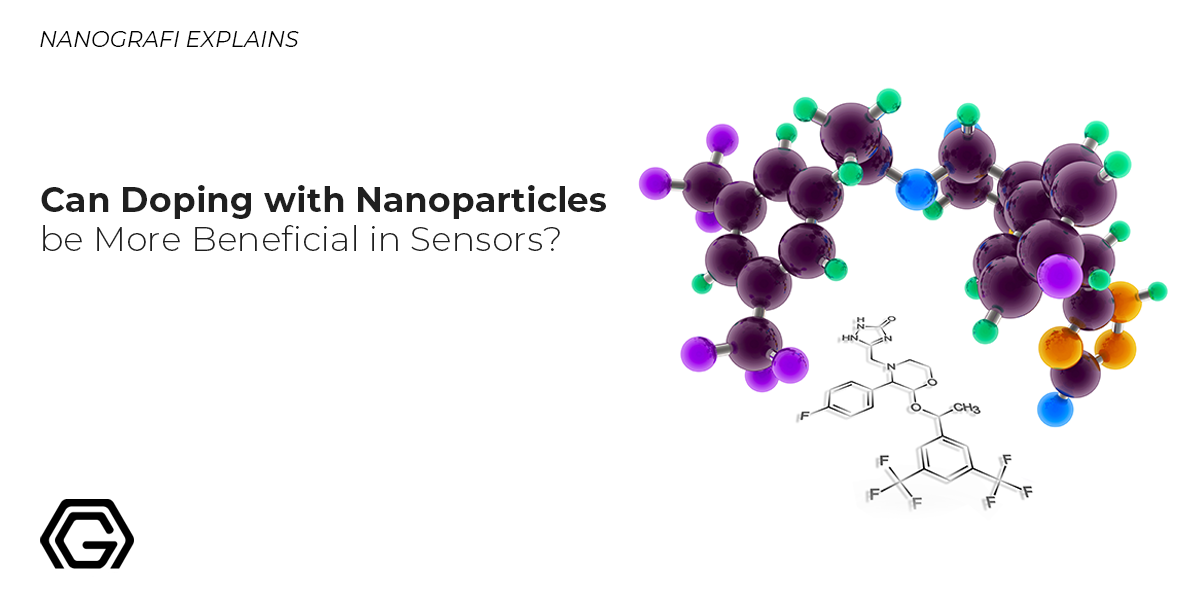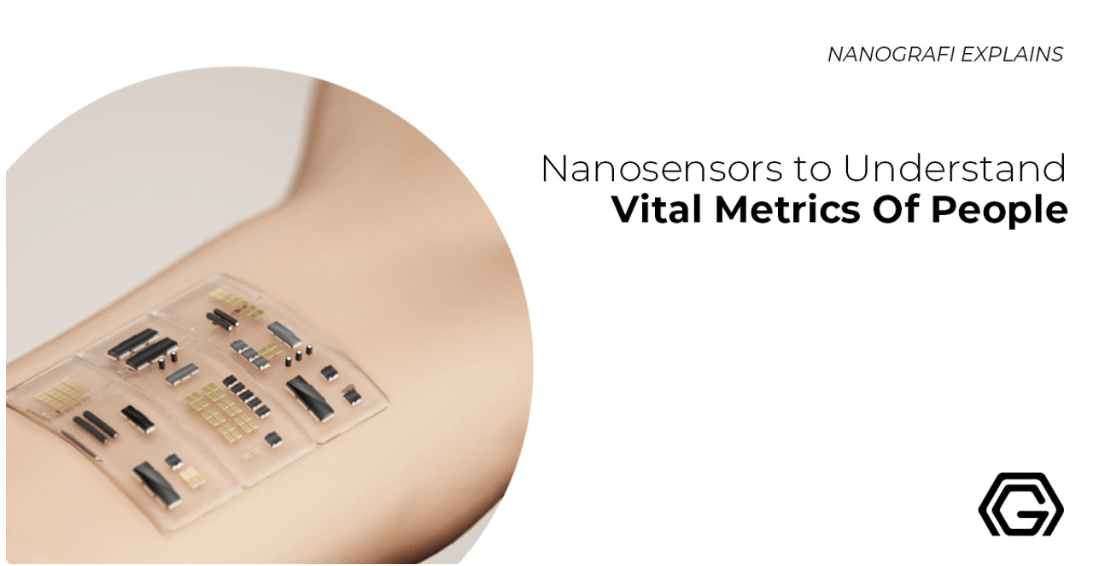Can Doping with Nanoparticles be More Beneficial in Sensors?
Sensors are made to detect any changes in electrical, chemical fields, etc. For highly sensitive sensing applications, semiconductors are produced when doping with nanoparticles. Nowadays, the doping process uses nanoparticles with a very high level of precision and accuracy to deliver semiconductor sensors.
The interest in them is because of the electrical conductivity that can be tuned and tuning can be done through facile polymerization, properties of soft organic material, and doping. When doping with nanomaterials of unique chemical and physical characteristics, as dopants, helps the conducting polymer in getting new and even enhanced properties, for instance, improved strength, improved conductivity, additional functional groups, and large surface area. We, Nanografi, offer semiconductors enhanced with our precision-engineered nanoparticles, delivering superior conductivity, strength, and sensitivity.
Introduction
When the conducting polymers are being doped with nanomaterials, the properties of nanomaterials and conducting polymers are combined, which has found a vast amount of applications in different fields, such as solar cells, catalysis, fuel cells, supercapacitors, thermoelectricity, and sensors. Theoretical and experimental evidence assured doping importance for the advancement in nanoscience and nanotechnology of new functional materials. This article mainly focuses on recent improvements in biosensors and electrochemical sensors, based on conducting polymers doped with different nanomaterials. In addition, there is a discussion on, selective NO2 gas sensors, using gold nanoparticles to create tunable sensors, Polystyrene nanoparticles, and biosensors, Nanoparticle doping, Hydrogen sensors based on ZnO nanoparticles.
Sensors detect changes in properties in various ways: chemical, electrical, mechanical, radiant, magnetic, or thermal. To date, semiconductor materials have been used in the manufacture of most sensors, enabling the creation of 3-D final products. A critical step in semiconductor manufacturing is doping. When nanoparticles are used as a dopant, semiconductors become suitable for applications in highly sensitive sensing. Doping is the process of introducing impurities into a material, imbuing it with the necessary properties for specific functionalities. Semiconductor materials are utilized to manufacture highly sensitive sensors, leveraging their electromagnetic properties with a high degree of precision and accuracy.
Over the last decade, advancements in nanotechnology have significantly improved the manufacturing of semiconductors. Many researchers are exploring the use of nanoparticles in doping for various sensor applications, and several examples are mentioned in this article.
Selective NO2 Gas Sensors
One notable application in this field is the synthesis of nickel-oxide (NiO) doped with cerium (Ce) using the sol-gel method. This particular combination has shown greater efficacy in sensing nitrogen dioxide (NO2) compared to traditional materials. The selective sensitivity of this doped NiO to NO2 makes it a prime example of how nanoparticle doping can enhance sensor capabilities. The enhanced sensitivity is particularly important in applications where detecting low concentrations of NO2 is crucial, such as in environmental monitoring and industrial safety.
Hydrogen Sensors Based on ZnO Nanoparticles
H2, ethanol, and CO are the gases that can be sensed by ZnO. As the bulk material has not sufficient sensitivity, Wang et al. employed Pd coated ZnO nanorods for detecting H2 down to 10 ppm, with a 2.6% relative response and a recovery time of less than 20 s at 25.8C. When the nanoparticles were impregnated with 1% Pt, Pt beneficial effects were added, which improved ZnO gas sensing characteristics. Further impregnation of Pt improves the recovery and response times. At low temperatures, Pt and Co doping ZnO nanoparticles represent very good sensitivity for H2. For long periods, over several cycles, ZnO nanoparticle sensors are stable, displaying their practical use as H2 sensors. In ZnO: Ag nanocolumnar films, the response and the recovery times are greatly lessened for the fully modified nanocolumnar thin films. Ag-doped ZnO columnar films improved the properties of sensing gases like acetone, ethanol, methanol, and 2-propanol vapours.
Creating Tunable Sensors Using Gold Nanoparticles
Doping tunable nature gives the manufacturers ability to accurately control impurities level in a volatile-organic-compound (VOC) and in the semiconductor materials sensing application. Molybdenum disulfide (MoS2) is doped with gold (Au) nanoparticles only a size of 10 nanometers. The charge was transferred in between Au and MoS2 because nanoparticles allowed, enabling the production of the sensors.
Biosensors by Using of Polystyrene Nanoparticles
In biosensing world, specific mechanical sensors are used for monitoring of bodily processes like pulse, swallowing, and back posture in real-time. Recently, it was showed how nanoparticles of polystyrene doping graphene oxide could act as a highly responsive piezoelectric, flexible sensor for this application.
Nanomaterial-Doped Conducting Polymers for Biosensors and Electrochemical Sensors
In 1977, polyacetylene, an organic polymer displayed a very high electronic conductivity when doped with iodine. Now, a huge amount of attention is gained by conducting polymers in fields like biomedical applications, bioelectronics, anti-corrosion, and storage of energy. The doping and properties of soft organic material tune the electrical conductivity, which makes this interesting. Dopants modulate extended π-conjugated molecular backbone, therefore, modulating electrical conductivity. Effective applications in biosensors and electrochemical sensors were seen.
Due to development, now for polymers' polymerization, nanomaterials that are carrying negative charges have been used as novel dopants. Improved or even remarkable properties, for instance, enhanced conductivity, large surface area, additional functional groups, and enhanced strength are attained when polymers are doped with nanomaterials because of the properties of nanomaterials and conducting polymers are combined. These have broad applications in different areas.Until now, the development of many conducting polymers has occurred, and the best of them are polyaniline (PANI), polyindole, and poly(3,4-ethylene dioxythiophene) (PEDOT).
Nanomaterial-Doped PEDOT
Due to the advantage of having high conductivity and super stability, PEDOT, the most widely and representative used derivative of polythiophenes. Combinations of nanomaterials and PEDOT together generate way many potentially promising composites which have witnessed rapid growth recently, in the electrochemical field.
Carbon Nanomaterial (CNT)-Doped PEDOT
Recently, carbon nanomaterials like Carbon nanotubes and GR have been implemented in PEDOT as dopants. With that help, different sensors are built up and with which impressive progress in sensing has been achieved.
In electrocatalysis, CNTs doping PEDOT nanocomposites are also of a huge deal. The performance was seen to be improved when nanoparticles were introduced on PEDOT-CNTs. Even in biosensors, CNT-doped PEDOT composites are also attractive materials.
Metal Nanoparticle-Doped PEDOT
High conductivity and a network of the 3D microporous structure was processed by the prepared nanomaterial. Also, nitrite's electrochemical sensing can be done by the production of the Au nanoclusters (AuNCs) doped PEDOT.
Other Nanomaterial-Doped PEDOT
Broad applications are possessed by these materials when it comes to sensing and promising application vistas in the sensors that are in development. For the doping of PEDOT, one good candidate was considered, known as nanocrystalline cellulose; this is because of its low cost, high surface area, and good biocompatibility. The performance of electrochemically polymerized PEDOT-NCC is better when it comes to electrocatalytic activity and charge storage capacity. We realized the sensitive detection for DA while its good electrocatalytic activity was exploited. H2O2 has a remarkable catalyst known as Prussian blue (PB), and it is prepared in nanoparticles form, and it's used for polymer's doping. A PB-PEDOT nanocomposite was used for H2O2 electrochemical catalytic reduction, and it was reported by Wang and his co-workers. In nanocomposite, the PEDOT does not only protect PB nanoparticles from realizing its high stability, but it also acts between nanoparticles of PB as the connector to increase its electrochemical performance.
To learn more about the role of nanosensors in understanding people vital metrics, visit our blog page.
Nanomaterial-Doped PANI
For modifying the electrode, PANI is the best material. PANI is studied in detail as a material that modifies electrode in different fields, like electronic devices, biosensors, batteries, and integrated circuits, due to its easy synthesis, unique electroactivity, good stability in the environment, unusual de-doping/doping chemistry, and high capacity, when different nanocomposites doped PANI, improved and better performance is exhibited by the materials.
Carbon Material-Doped PANI
Carbon nanotubes are the best carbon material. Doping of Polymeric nanocomposites of PANI with carbon materials are superior and have more functions and properties as compared to those of the pure component's nanoparticle dispersion, mechanical stability, selectivity, and detection sensitivity so that they can play significant roles in biosensors and chemical sensors. Few carbon materials, for instance, CNTs and GR, have been used widely.
Other Nanomaterial-Doped PANI
Based on PANI, a broad range of nanocomposites are applied as dopants.
Nanomaterial-Doped PPy
Another very attractive material for sensor applications is PPy which can be polymerized easily in neutral aqueous solution as compared to that of polythiophene and PANI, which needs acidic media. It is broadly used to fabricate biosensors or electrochemical sensors because of its acceptable stability and high electrical conductivity. For development in both biosensors and electrochemical sensors, composites of polythiophene that are nanomaterial-doped were used broadly. Nandini et al. prepared another H2O2 sensor based on polythiophene that's doped with AuNP nanotube (AuNPNTs).
It is seen that by doping nanocomposites of Poly(p-phenylene sulfide) PPS with specific nanomaterials, for instance, carbon nanofibers, and CNT, Poly(p-phenylene sulfide) PPS nanocomposites performance was improved effectively. It's estimated that PPS doped with nanomaterial might find exceptional applications in both biosensing and electrochemical sensing in the future.
Electrochemiluminescence and Nanoparticle Doping
It's proved that for the manufacturing of sensitive sensing devices, semiconductor materials are used which are produced by combining nanoparticles' doping with the electrochemiluminescence (ECL) transduction method. For applications in biosensing, this method is specifically interesting because if the mechanical and chemical events can be sensed beforehand, we would be able to differentiate between life-saving diagnoses, deadly uncertainty, and early diagnoses.
Conclusion
The properties and qualities of the dopant when mixed with the properties of nanomaterial, will make it better than ever. Nanoparticle-doped materials considerably enhance the sensing performance, for instance, low limit of detection, rapid response, good selectivity, high repeatability, as well as enabling the preparation of facile. Each dopant has some particular catalytic activity towards various targets, so conducting polymers being doped with more than just one dopant is great as the product will have combined properties of all. An interesting fact is that the electrical conductivity can be tuned by the dopants by modulating the prolonged π-conjugated molecular backbone. Applications in electrochemical sensors and biosensors were noticed. This article also focuses on how to use gold particles to create tunable sensors, and selective NO2 gas sensors are also discussed.
To explore our blogs that examine educational and current developments in nanotechnology, visit Blografi.
References
Can Doping with Nanoparticles Be More Beneficial in Sensors? (n.d.). Retrieved January 29, 2024, from https://www.azonano.com/article.aspx?ArticleID=5478
Future of Solar Cells with Nanotechnology Solar Energy - Nanografi Nano Technology. (n.d.). Retrieved January 29, 2024, from https://nanografi.com/blog/future-of-solar-cells-with-nanotechnology-solar-energy/
Khan, I., Saeed, K., & Khan, I. (2019). Nanoparticles: Properties, applications and toxicities. Arabian Journal of Chemistry, 12(7), 908–931. https://doi.org/10.1016/J.ARABJC.2017.05.011
Nanosensors to Understand Vital Metrics Of People - Nanografi Nano Technology. (n.d.). Retrieved January 29, 2024, from https://nanografi.com/blog/nanosensors-to-understand-vital-metrics-of-people/
Postica, V., Vahl, A., Santos-Carballal, D., Dankwort, T., Kienle, L., Hoppe, M., Cadi-Essadek, A., De Leeuw, N. H., Terasa, M. I., Adelung, R., Faupel, F., & Lupan, O. (2019a). Tuning ZnO Sensors Reactivity toward Volatile Organic Compounds via Ag Doping and Nanoparticle Functionalization. ACS Applied Materials and Interfaces, 11(34), 31452–31466. https://doi.org/10.1021/ACSAMI.9B07275/ASSET/IMAGES/LARGE/AM9B07275_0001.JPEG
Postica, V., Vahl, A., Santos-Carballal, D., Dankwort, T., Kienle, L., Hoppe, M., Cadi-Essadek, A., De Leeuw, N. H., Terasa, M. I., Adelung, R., Faupel, F., & Lupan, O. (2019b). Tuning ZnO Sensors Reactivity toward Volatile Organic Compounds via Ag Doping and Nanoparticle Functionalization. ACS Applied Materials and Interfaces, 11(34), 31452–31466. https://doi.org/10.1021/ACSAMI.9B07275/ASSET/IMAGES/LARGE/AM9B07275_0001.JPEG
Wang, G., Morrin, A., Li, M., Liu, N., & Luo, X. (2018). Nanomaterial-doped conducting polymers for electrochemical sensors and biosensors. Journal of Materials Chemistry B, 6(25), 4173–4190. https://doi.org/10.1039/C8TB00817E
Yuan, Z., Li, R., Meng, F., Zhang, J., Zuo, K., & Han, E. (2019). Approaches to Enhancing Gas Sensing Properties: A Review. Sensors (Basel, Switzerland), 19(7). https://doi.org/10.3390/S19071495
Recent Posts
-
Nanocomposites in Food Packaging
The utilization of nanocomposites in food packaging represents a significant advancement in the fiel …19th Apr 2024 -
What is the Difference Between 7075 and 6061 Aluminum Alloy?
When comparing 7075 aluminum alloy to 6061 aluminum alloy, it's essential to understand their disti …5th Apr 2024 -
Iron-Air Batteries: The Ultimate Guide
Iron-air batteries represent a significant breakthrough in energy storage technology, offering a sus …29th Mar 2024







